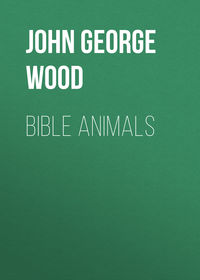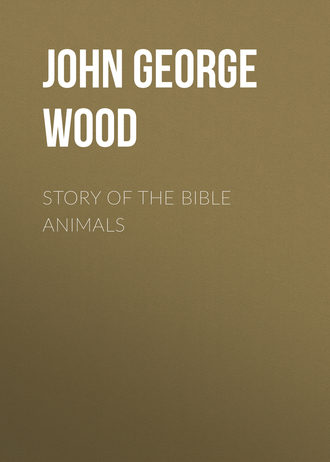 полная версия
полная версияStory of the Bible Animals
"The next process was that of the fleecing and roasting of the slaughtered animals, for which the ancient temple furnished such ample provisions. Two holes on the mountain side had been dug; one at some distance, of considerable depth, the other, close to the scene of the sacrifice, comparatively shallow. In this latter cavity, after a short prayer, a fire was kindled, out of the mass of dry heath, juniper, and briers, such as furnished the materials for the conflagration in Jotham's parable, delivered not far from this spot.
"Over the fire were placed two caldrons full of water. Whilst the water boiled, the congregation again stood around, and (as if for economy of time) continued the recitation of the Book of Exodus, and bitter herbs were handed round wrapped in a strip of unleavened bread—'with unleavened bread and bitter herbs shall they eat it.' Then was chanted another short prayer; after which the six youths again appeared, poured the boiling water over the sheep, and plucked off their fleeces. The right forelegs of the sheep, with the entrails, were thrown aside and burnt. The liver was carefully put back. Long poles were brought, on which the animals were spitted; near the bottom of each pole was a transverse peg or stick, to prevent the body from slipping off."
This cross-piece does not, however, penetrate the body, which in most cases scarcely touches it, so that there is little or no resemblance to a crucifixion. The writer lays especial stress on this point, because the early Christians saw in the transverse spit an emblem of the cross. In the Jewish Passover this emblem would have been more appropriate, as in that ceremony the cross-piece was passed through the shoulders, and the forefeet tied to it.
The Sheep being now prepared, they were carried to the oven, which on this occasion was a deep, circular pit, in which a fire had been previously kindled. Into this the victims were carefully lowered, the stakes on which they were impaled guarding their bodies from touching the sides of the oven, and the cross-piece at the end preventing them from slipping off the stake to the bottom of the pit among the ashes. A hurdle was then laid on the mouth of the pit, and wet earth was heaped upon it so as to close it completely. The greater part of the community then retired to rest. In about five hours, the Paschal moon being high in the heavens, announcement was made that the feast was about to begin. Then, to resume Dean Stanley's narrative,
"Suddenly the covering of the hole was torn off, and up rose into the still moonlit sky a vast column of smoke and steam; recalling, with a shock of surprise, that, even by an accidental coincidence, Reginald Heber should have so well caught this striking feature of so remote and unknown a ritual:
'Smokes on Gerizim's mount Samaria's sacrifice.'
"Out of the pit were dragged successively the six sheep, on their long spits, black from the oven. The outlines of their heads, their ears, their legs, were still visible—'his head, with his legs, and with the inward parts thereof.' They were hoisted aloft, and then thrown on large square brown mats, previously prepared for their reception, on which we were carefully prevented from treading, as also from touching even the extremities of the spit.
"The bodies thus wrapped in the mats were hurried down to the trench where the sacrifice had taken place, and laid out upon them in a line between two files of the Samaritans. Those who had before been dressed in white robes still retained them, with the addition now of shoes on their feet and staves in their hands, and ropes round their waists—'thus shall ye eat it; with your loins girded, your shoes on your feet, your staff in your hand.' The recitation of prayers or of the Pentateuch recommenced, and continued till it suddenly terminated in their all sitting down on their haunches, after the Arab fashion at meals, and beginning to eat. This, too, is a deviation from the practice of only a few years since, when they retained the Mosaic ritual of standing whilst they ate. The actual feast was conducted in rapid silence, as of men in hunger, as no doubt most of them were, and so as soon to consume every portion of the blackened masses, which they tore away piecemeal with their fingers—'ye shall eat in haste.' There was a general merriment, as of a hearty and welcome meal.
"In ten minutes all was gone but a few remnants. To the priest and to the women, who, all but two (probably his two wives), remained in the tents, separate morsels were carried round. The remnants were gathered into the mats, and put on a wooden grate, or hurdle, over the hole where the water had been originally boiled; the fire was again lit, and a huge bonfire was kindled. By its blaze, and by candles lighted for the purpose, the ground was searched in every direction, as for the consecrated particles of sacramental elements; and these fragments of flesh and bone were thrown upon the burning mass—'ye shall let nothing remain until the morning; and that which remaineth until the morning ye shall burn with fire;' 'there shall not anything of the flesh which thou sacrificest the first day at even remain all night until the morning;' 'thou shalt not carry forth aught of the flesh abroad out of the house.' The flames blazed up once more, and then gradually sank away.
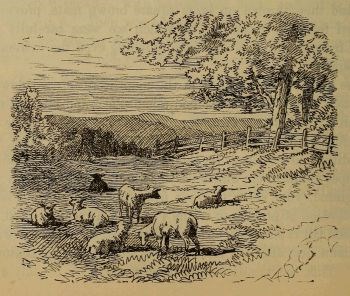
"Perhaps in another century the fire on Mount Gerizim will be the only relic left of this most interesting and ancient rite."

THE CHAMOIS
The Zemer or Chamois only once mentioned in the Bible—Signification of the word Zemer—Probability that the Zemer is the Aoudad—Its strength and activity—The Mouflon probably classed with the Aoudad under the name of Zemer.
Among the animals which may be used for food is mentioned one which in our version is rendered Chamois. See Deut. xiv. 5, a passage which has several times been quoted.
It is evident to any one acquainted with zoology that, whatever may be the Hebrew word, "Chamois" cannot be the correct rendering, inasmuch as this animal does not inhabit Palestine, nor are there any proofs that it ever did so. The Chamois frequents the lofty inaccessible crags of the highest mountains, finding its food in the scanty herbage which grows in such regions, appearing on the brink of awful precipices, and leaping from ledge to ledge with ease and safety. We must, therefore, look for some other animal.
The Chamois is one of the most wary of Antelopes, and possesses the power of scenting mankind at what would seem to be an impossible distance.
Its ears are as acute as its nostrils, so that there are few animals which are so difficult to approach.
Only those who have been trained to climb the giddy heights of the Alpine Mountains, to traverse the most fearful precipices with a quiet pulse and steady head, to exist for days amid the terrible solitudes of ice, rock, and snow,—only these, can hope to come within sight of the Chamois, when the animal is at large upon its native cliffs.
The Hebrew word, which has been rendered Chamois, is Zamar, or Zemer, i. e. the leaper, and therefore an animal which is conspicuous for its agility. Zoologists have now agreed in the opinion that the Zamer of Deuteronomy is the handsome wild sheep which we know under the name of Aoudad (Ammotragus Tragelaphus). This splendid sheep is known by various names. It is the Jaela of some authors, and the Bearded Sheep of others. It is also called the Fichtall, or Lerwea; and the French zoologists describe it under the name of Mouflon à manchettes, in allusion to the fringe of long hair that ornaments the fore limbs.
The Aoudad is a large and powerful animal, exceedingly active, and has the habits of the goat rather than of the sheep, on which account it is reckoned among the goats by the Arabs of the present day, and doubtless was similarly classed by the ancient inhabitants of Palestine. The height of the adult Aoudad is about three feet, and its general colour is pale dun, relieved by the dark masses of long hair that fall from the neck and the tufts of similar hair which decorate the knees of the male. The female is also bearded and tufted, but the hair, which in the male looks like the mane of the lion, in the female is but slightly developed.
It is so powerful and active an animal, that an adult male which lived for some time in the Zoological Gardens was much dreaded by the keepers, not even the man who fed it liking to enter the enclosure if he could help himself. The animal was given to making unexpected charges, and would do so with astonishing quickness, springing round and leaping at the object of his hate with tremendous force, and with such rapidity that even the experienced keeper, who knew all the ways of the animals under his charge, had often some difficulty in slipping behind the door, against which the horns of the Aoudad would clatter as if they would break the door to pieces. So fond was he of attacking something that he would often butt repeatedly at the wooden side of the shed, hurling himself against it with eager fury.
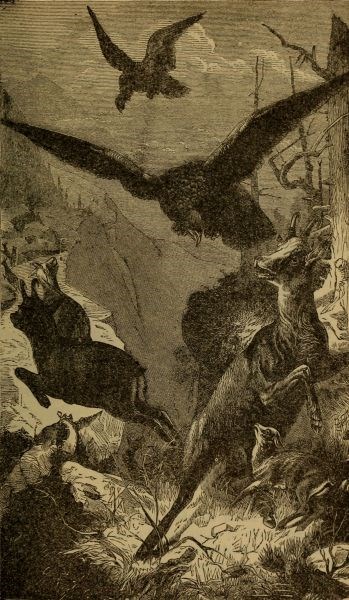
CHAMOIS DEFENDING ITS YOUNG.
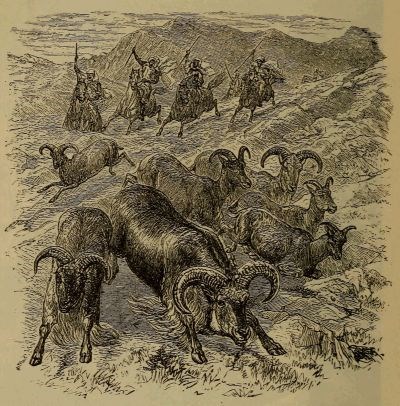
CHASING THE AOUDAD.
The horns of the Aoudad are about two feet in length, and are of considerable diameter. They curve boldly and gracefully backwards, their points diverging considerably from each other, so that when the animal throws its head up, the points of the horns come on either side of the back. This divergence of the horns has another object. They cover a considerable space, so that when the animal makes its charge the object of its anger has much more difficulty in escaping the blow than if the horns were closer together.
Whether these horns were used as musical instruments is doubtful, simply because we are not absolutely sure that the Zamar and the Aoudad are identical, however great may be the probability. But inasmuch as the horn-trumpets were evidently of various sizes, it is certain that the Jewish musicians would never have neglected to take advantage of such magnificent materials as they would obtain from the horns of this animal. Perhaps the Chaldaic "keren" may have been the horn of the Aoudad, or of the animal which will next be mentioned.
The Aoudad is wonderfully active, and even the young ones bound to an astonishing height. I have seen the marks of their hoofs eight feet from the ground.
In its wild state the Aoudad lives in little flocks or herds, and prefers the high and rocky ground, over which it leaps with a sure-footed agility equal to that of the Chamois itself. These flocks are chased by hunters, who try to get it upon the lowest and least broken ground, where it is at a disadvantage, and then run it down with their horses, as seen in the illustration on page 214.
The Aoudad was formerly plentiful in Egypt, and even now is found along the Atlas mountain-range. It is seen on the Egyptian monuments, and, owing to its evident profusion, we have every reason to conjecture that it was one of those animals which were specially indicated as chewing the cud and cleaving the hoof.
Perhaps the Mouflon (Caprovis Musimon) may be the animal which is meant by the Hebrew word Zamar, and it is not unlikely that both animals may have been included in one name.
This animal, which is nearly allied to the Aoudad, is also very goatlike in general aspect. It is indeed to this resemblance that the name Caprovis, or goat-sheep, has been given to it. The name Ammotragus, which, as mentioned above, belongs to the Aoudad, has a similar signification.
The horns of the Mouflon belong only to the male animal, and are of enormous size, so that if trumpets of deep tone and great power were needed, they could be obtained from the horns of this animal. Those of the Aoudad are very large, and would be well adapted for the same purpose, but they would not furnish such instruments as the horns of the Mouflon, which are so large that they seem almost unwieldy for an animal of twice the Mouflon's size, and give visible proofs of the strength and agility of an animal which can carry them so lightly and leap about under their weight so easily as does the Mouflon.

THE MOUFLON.
At the present time the Mouflon is only to be found in Crete, Sardinia, and Corsica, but formerly it was known to inhabit many other parts of the earth, and was almost certainly one of the many animals which then haunted the Lebanon, but which have in later days been extirpated.
THE GOAT
Value of the Goat—Its use in furnishing food—The male kid the usual animal of slaughter—Excellence of the flesh and deception of Isaac—Milk of the Goat—An Oriental milking scene—The hair of the goat, and the uses to which it is put—The Goat's skin used for leather—The "bottle" of Scripture—Mode of making and repairing the bottles—Ruse of the Gibeonites—The "bottle in the smoke"—The sacks and the kneading troughs—The Goat as used for sacrifice—General habits of the Goat—Separation of the Goats from the sheep—Performing Goats—Different breeds of Goats in Palestine.
Whether considered in reference to food, to clothing, or to sacrifice, the Goat was scarcely a less important animal than the sheep. It was especially valuable in such a country as Palestine, in which the soil and the climate vary so much according to the locality. Upon the large fertile plains the sheep are bred in vast flocks, the rich and succulent grass being exactly to their taste; while in the hilly and craggy districts the Goats abound, and delight in browsing upon the scanty herbage that grows upon the mountain-side.
For food the Goat was even more extensively used than the sheep. The adult male was, of course, not eaten, being very tough, and having an odour which would repel any but an actually starving man. Neither were the females generally eaten, as they were needed for the future increase of the flocks. The young male kid formed the principal material of a feast, and as soon as a stranger claimed the hospitality of a man in good circumstances, the first thing that was done was to take a young male kid and dress it for him.
For example, when the angel visited Gideon in the guise of a stranger, Gideon "went in and made ready a kid, and unleavened cakes of an ephah of flour," and brought them to his guest (Judges vi. 19). And when Isaac was on his death-bed and asked Esau to take his bow and arrows and hunt for "venison," which was probably the flesh of one of the antelopes which have already been mentioned, a ready substitute was found in the two kids, from whose flesh Rebekah made the dish for which he longed. The imposition might easily pass without detection, because the flesh of the kid is peculiarly tender, and can scarcely be distinguished from lamb, even when simply roasted. Isaac, therefore, with his senses dulled by his great age, was the less likely to discover the imposture, when the flesh of the kids was stewed into "savoury meat such as he loved."

JACOB DECEIVES HIS FATHER AND TAKES ESAU'S BLESSING.
A curious illustration of the prevalence of kid's flesh as food is given in the parable of the prodigal son, for whom his father had killed the fatted calf. "And he answering said to his father, Lo, these many years do I serve thee, neither transgressed I at any time thy commandment: and yet thou never gavest me a kid, that I might make merry with my friends" (Luke xv. 29). The force of the reproval cannot be properly understood unless we are acquainted with the customs of the East. The kid was the least valuable animal that could have been given, less valuable than a lamb, and infinitely inferior to the fatted calf, which was kept in wealthy households for some feast of more than ordinary magnificence.
The kid was cooked exactly in the same manner as the sheep, namely, by cutting to pieces and stewing in a caldron, the meat and broth being served separately. See, for example, the case of Gideon, to whom a reference has already been made. When he brought the banquet to his guest, "the flesh he put in a basket, and he put the broth in a pot, and brought it out unto him under the oak, and presented it. And the angel of God said unto him, Take the flesh and the unleavened cakes, and lay them upon this rock, and pour out the broth."
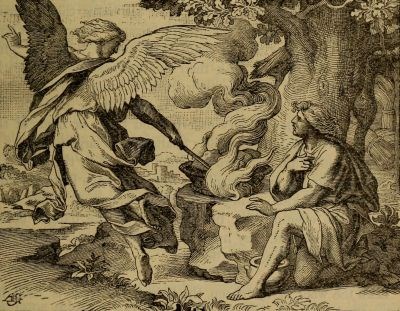
THE ANGEL APPEARS TO GIDEON.
Gideon did so, and the angel reached forth the staff that was in his hand, and touched the flesh, and there rose up fire out of the rock and burnt up the offering.
The same custom exists at the present day. When an Arab chief receives a guest, a kid is immediately killed and given to the women to be cooked, and the guest is pressed to stay until it is ready, in the very words used by Gideon three thousand years ago. "Depart not hence, I pray thee, until I come unto thee, and bring forth my present, and set it before thee." The refusal of proffered hospitality would be, and still is considered to be, either a studied insult, or a proof of bad manners, and no one with any claims to breeding would commit such an action without urgent cause and much apology.
Like the sheep, the Goat is extremely valuable as a milk-producer, and at the present day the milk of the Goat is used as largely as that of the sheep. "At Rasheiya, under Mount Hermon," writes Mr. Tristram, "we saw some hundreds of goats gathering for the night in the wide open market-place beneath the castle. It was no easy matter to thread our way among them, as they had no idea of moving for such belated intruders on their rest. All the she-goats of the neighbouring hills are driven in every evening, and remain for their morning's milking, after which they set forth on their day's excursion.
"Each house possesses several, and all know their owners. The evening milking is a picturesque scene. Every street and open space is filled with the goats; and women, boys, and girls are everywhere milking with their small pewter pots, while the goats are anxiously awaiting their turn, or lying down to chew the cud as soon as it is over. As no kids or he-goats are admitted, the scene is very orderly, and there is none of the deafening bleating which usually characterises large flocks.
"These mountain goats are a solemn set, and by the gravity of their demeanour excite a suspicion that they have had no youth, and never were kids. They need no herdsman to bring them home in the evening, for, fully sensible of the danger of remaining unprotected, they hurry homewards of their own accord as soon as the sun begins to decline."
Like the wool of the sheep, the hair of the Goat is used for the manufacture of clothing; and, as is the case with wool, its quality differs according to the particular breed of the animal, which assumes almost as many varieties as the sheep or the dog. The hair of some varieties is thick and rough, and can only be made into coarse cloths, while others, of which the mohair Goat and Cashmere Goat are familiar examples, furnish a staple of surpassing delicacy and fineness. It is most likely that the covering and curtains of the Tabernacle mentioned in Exod. xxvi. 7 were of the latter kind, as otherwise they would have been out of character with the fine linen, and blue and scarlet, their golden clasps, and the profuse magnificence which distinguished every part of the sacred building. Moreover, the hair of the Goat is classed among the costly offerings which were made when the Tabernacle was built. "And they came forth, men and women, as many as were willing hearted, and brought bracelets, and earrings, and rings, and tablets, all jewels of gold: and every man that offered offered an offering of gold unto the Lord. And every man, with whom was found blue, and purple, and scarlet, and fine linen, and goats' hair, and red skins of rams, and badgers' skins, brought them" to be used in the structure of that wonderful building, in which nothing might be used except the finest and costliest that could be procured.
One of the principal uses to which the goat-skin was applied was the manufacture of leather, for which purpose it is still used, and is considered far better than that of the sheep. Perhaps the most common form in which this leather is used is the well-known water-vessel, or "bottle" of the Bible.
These so-called bottles are made from the entire skin of the animal, which is prepared in slightly different methods according to the locality in which the manufacture is carried on. In Palestine they are soaked for some little time in the tanning mixture, and are then filled with water, after the seams have been pitched. In this state they are kept for some time, and are kept exposed to the sun, covered entirely with the tanning fluid, and filled up with water to supply the loss caused by evaporation and leakage.
The hair is allowed to remain on the skins, because it acts as a preservative against the rough usage to which they are subject at the hard hands of the water-carriers. By degrees the hairy covering wears off, first in patches, and then over the entire surface, so that a new bottle can be recognised at a glance, and any one who wished to sell an old bottle at the price of a new one would be at once detected.
Vessels made in this rude manner are absolutely necessary in the countries wherein they are used. Wooden or metal vessels would be too heavy, and, besides, the slight though constant evaporation that always takes place through the pores of the leather keeps down the temperature of the water, even under a burning sun, the slight loss which is caused by the porousness of the skin being more than counterbalanced by the coolness of the water. It is true that the goat-skin communicates to the liquid a flavour far from pleasant, but in those countries the quality of the water is of little consequence, provided that it is plentiful in quantity, and tolerably cool.
In all parts of the world where the skin is used for this purpose the mode of manufacture is practically identical. An account of the art of preparing the goat-skin as practised in Abyssinia is given by Mr. C. Johnston, in his "Travels in Southern Abyssinia:"—
"To be of any value it must be taken off uncut, except around the neck, and in those situations necessary to enable the butchers to draw the legs out of the skin; also, of course, where the first incision is made to commence the process, and which is a circular cut carried around both haunches, not many inches from and having the tail for a centre. The hide is then stripped over the thighs, and two smaller incisions being made round the middle joint of the hind-legs enable them to be drawn out.
"A stick is now placed to extend these extremities, and by this, for the convenience of the operators, the whole carcase is suspended from the branch of a tree, and, by some easy pulls around the body, the skin is gradually withdrawn over the fore-legs, which are incised around the knees, to admit of their being taken out; after which, the head being removed, the whole business concludes by the skin being pulled inside out over the decollated neck. One of the parties now takes a rough stone and well rubs the inside surface, to divest it of a few fibres of the subcutaneous muscle which are inserted into the skin, and after this operation it is laid aside until the next day; the more interesting business of attending to the meat calling for immediate attention.
"These entire skins are afterwards made into sacks by the apertures around the neck and legs being secured by a double fold of the skin being sewed upon each other, by means of a slender but very tough thong. These small seams are rendered quite air-tight, and the larger orifice around the haunches being gathered together by the hands, the yet raw skin is distended with air; and the orifice being then tied up, the swollen bag is left in that state for a few days, until slight putrefaction has commenced, when the application of the rough stone soon divests its surface of the hair. After this has been effected, a deal of labour, during at least one day, is required to soften the distended skin by beating it with heavy sticks, or trampling upon it for hours together, the labourer supporting himself by clinging to the bough of a tree overhead, or holding on by the wall of the house.



